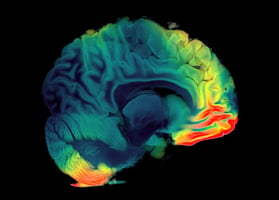People at High Risk for Psychosis Found to Have Thinner Cortex

Individuals who are at high risk for psychosis appear to have a thinner cortex as measured by structural magnetic resonance imaging (sMRI) than healthy individuals, according to a report in JAMA Psychiatry.
Moreover, lower brain volume measurements among at-risk individuals, especially between the ages of 12 and 16, appear to predict whether they will later become acutely psychotic. “Findings from this international effort suggest that conversion to psychosis among those at clinical high risk is associated with lower cortical thickness (CT) at baseline,” write Maria Jalbrzikowski, Ph.D., an assistant professor of psychiatry at the University of Pittsburgh, and colleagues.
The researchers analyzed sMRI images of the brains of 1,792 individuals at clinical high risk (CHR) for psychosis, including 253 individuals who later developed acute psychosis, and 1,377 healthy controls at 31 centers around the world participating in the ENIGMA Clinical High Risk for Psychosis Working Group. From the sMRI images, they formulated 155 measures of cortical thickness, surface area, and subcortical volume, as well as three global neuroimaging measures—total intracranial volume, average cortical thickness, and total surface area.
High-risk participants had smaller overall brain volume measurements compared with healthy controls, with the greatest difference in cortical thickness. (There was no difference in cortical surface area or subcortical volume.) Additionally, the 253 individuals who later developed psychosis had thinner cortexes than the high-risk individuals who did not develop psychosis and the healthy controls in three brain regions—the paracentral, superior temporal, and fusiform regions.
Finally, compared with the healthy control group, those aged 12 to 16 in the high-risk group—including those who did and did not later develop psychosis—had significantly thinner cortexes in the paracentral and fusiform region.
“In the largest study of brain abnormalities in individuals at CHR to date, we found robust evidence of a subtle, widespread pattern of CT differences, consistent with observations in psychosis,” the investigators write. “These findings also point to age ranges … when morphometric abnormalities in individuals at CHR might be greatest.”
For related information, see the Psychiatric News article “Imaging Advances Could Aid Outcome in High-Risk Patients.”
(Image: iStock/filo)
Make Plans Now to Attend Royal College of Psychiatrists Meeting, June 21-24
Join thousands of psychiatrists worldwide at the Royal College of Psychiatrists’ first-ever Virtual International Congress. The Congress will take place June 21 to 24 on an interactive and immersive event platform.
Don't miss out! To learn about newly posted articles in Psychiatric News, please sign up here.





